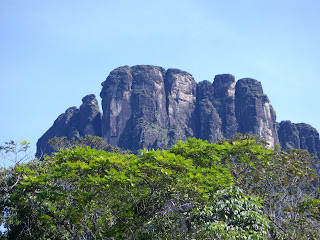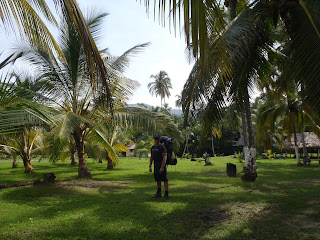In and Around Mérida
After doing the Venezuelan Dinero Shuffle, waiting at the bus station for about 8 hours and another long bus ride, we finally made it to the Andean city of Mérida. We were greeted at the bus station by Dieter Andersson, a German ex-pat who ran the Posada Alemania. He spoke very good English, gave us a map of the town and took us to a taxi, making sure that we would pay the right price and get to the posada safe and sound. With it's homely, comfortable style, lovely courtyard, central location and all the right facilities, it was a perfect place for us to stay.
As seen in the posada's courtyard
Mérida is a pleasant university town and is popular with tourists because it is the place in Venezuela to do adventure sports, from trekking and paragliding to rafting and canyoning. We were there, however, to see the Catatumbo lightning.
The Relámpago de Catatumbo occurs near the Río Catatumbo at bottom of Lake Maracaibo. It is an unusual phenomenon of lightning without thunder. There are several hypotheses as to why it happens, but the popular theory is that it has to do with the topography - a vast sea-level lake in very close proximity to the 5000m-high Andes - and the clash of the cold winds blowing down from the mountains and the hot, humid air evaporating from the lake ionise the air particles responsible for the lightning.
We booked a 2-day tour with the tour operator associated with the posada, and after a day of relaxing and watching the birds in the courtyard, we jumped in a truck with two Germans and a Swiss bloke along with our guide, Justin, and headed north towards Lago de Maracaibo. On the way we had to stop for petrol, which was unbelievably cheap.
Yes, that's about 37 litres for BS2.58 or 7 céntimos a litre
Our first stop was an old coffee finca (farm), Hacienda "El Carmen", a couple of hours from Mérida. They were a larger operation than the Plantation House in Salento, but they weren't picking berries at the moment. They had a cool collection of farming equipment like saddles, motors and old coffee processing machines. The finca is nearly 150 years old, so they've had a lot of time to collect them.
We headed to "the pirates cave" next, where we had lunch. The story goes that a 18th century brigand hid his treasure chest somewhere in these extensive maze of caves but no one has been able to find it.
Entrance to the Pirate's Cave
A representation of the lost treasure
Lovely scenery around the caves
We switched to a boat for the last part of our journey which took us down a river, past troops of red howler monkeys, and onto the lake, where we would be spending the night in a small community consisting entirely of buildings on stilts. They had a school, church (next to the Plaza Bolívar) and medical centre, all accessible by boat only.
A typical house
The church
View of the town from the church steeple
People keep all kinds of pets - dogs, cats, chickens and even pigs like this one
Don't have a boat? Use styrofoam packaging like these kids
We stayed in hammocks on the balcony and snatched sleep in between watching the strange, silent lightning flashing behind clouds, giving them an orange glow. At 5.30am we were hit by a massive storm with white lightning, thunder and wind, and retreated inside the house till it was safe to put up the hammocks outside again.
After breakfast, it was time to head back, this time winding our way along a river past many small farms before hitting Lake Maracaibo again.
A typical farmhouse
The Venezuelan River Cow (very common around this river)
Cool river bird (I think it's some kind of crake)
Some herons take flight
An osprey
We made two stops on our way back to Mérida. The first was a pretty colonial town where the smell of coffee from a local roasting business hung over the square.
The last stop for the tour was at a panela factory. Panela (known by several names around the world, including jaggery in India) is unrefined whole cane sugar and is basically a solid piece of sucrose and fructose obtained from the boiling and evaporation of sugarcane juice. We were able to watch the whole process from the squeezing of the juice from the sugar cane to the wrapping of the blocks of panela.
First step: the sugar cane is crushed in this machine and the juice...
... is transported into the first of a series of troughs
The liquid is heated to an extremely high temperature. Gunk is scooped off and it is moved through the troughs, getting purer and purer
The liquid is poured into the final trough...
... and then poured into these moulds
When the bricks are cool, they are wrapped and delivered to the shops
Canaima and Angel Falls
Canaima National Park is a beautiful place, most famous for its tepuis (sandstone table mountains) and the world's tallest waterfall, Angel Falls. It inspired the settings for Sir Arthur Conan Doyle's The Lost World and the Pixar animated film Up.
I think it's best to let the photos show you:
The "grand savanna"
The Orinoco delta
Our first tepui
On top of the tepuis are some very strange rock structures
I reckon these look like the Beatles, L-R: John, Ringo, Paul & George
Starting our canoe ride up to Angel Falls
More beautiful tepuis
Our first glimpse of Angel Falls
Happy anniversary!
This water is cold
Frolicking in the water under the 983m high Angel Falls
Angel Falls from the campsite in the morning
The falls and beach at Canaima
Walking behind Sapo Falls
Sapo Falls
Above Sapo Falls
That's a whole lot of water
Sunset behind the falls
Thanks to everyone who made our trip to Canaima fun, especially Bruno, Franci, Florian aka Capitán Pollo and Adrian aka The Flying Dutchman.






































































